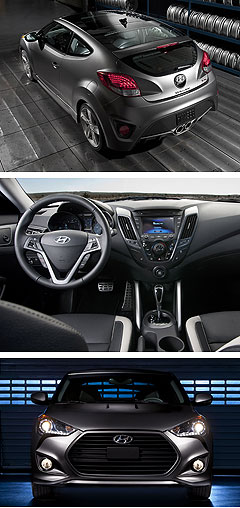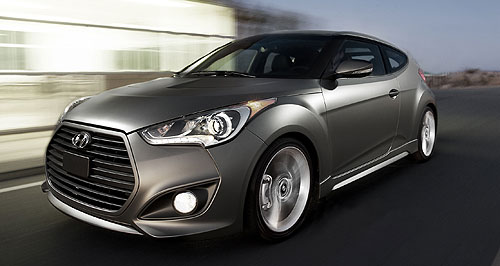Make / Model Search
Future models - Hyundai - Veloster - TurboDetroit show: Turbo turns up Veloster velocityQuick Korean: Hyundai has its eye on the Golf GTI with its turbocharged Veloster variant. Hyundai finally presents Tiburon replacement, but local release some time away10 Jan 2012 HYUNDAI has targetted the Mini Cooper S Coupe, Volkswagen Golf GTI, Honda CR-Z and upcoming Toyota 86 with a new Veloster Turbo that surfaced for the first time at the North American International Auto Show in Detroit this week. Australian release has been confirmed, although it will not go on sale here until the end of this year at the earliest. Based on the unique 3+1-door coupe/hatch that finally arrives here in mid-February, the performance version will be the first ‘driver’s car’ from Hyundai since the demise of the Tiburon V6 some 15 months ago. From the front, the Turbo is differentiated from the naturally aspirated Veloster by an aggressively restyled nose featuring a bold hexagonal grille opening, LED headlights, larger foglight surrounds and special aerodynamic foils for improved air flow. New 18-inch alloy wheel designs with chrome insets, body side skirts, lower ride height and a revised rear bumper with more prominent diffusers also distinguish the Turbo, which is 30mm longer and 152mm wider than the standard Veloster. The show car’s ‘Matte Gray’ paint is a Hyundai first, though white, blue and orange are also among the colour options. Hyundai claims the large round exhaust pipes, replacing the regular car’s central trapezoidal outlet, was inspired by customised sports motorcycles.  At the car’s heart is a new 1.6-litre turbocharged direct-injection four-cylinder petrol engine producing 150kW of power at 6000rpm and 264Nm of torque from 1750 to 4500rpm. At the car’s heart is a new 1.6-litre turbocharged direct-injection four-cylinder petrol engine producing 150kW of power at 6000rpm and 264Nm of torque from 1750 to 4500rpm.Power is transmitted to the front wheels via a six-speed manual or conventional torque-converter six-speed automatic gearbox with paddle shifters – both of which were developed in-house. The auto replaces the dual-clutch transmission offered on the naturally aspirated models for reasons of durability and driveability due to the extra torque load. Along with a heady 93.6kW per litre, Hyundai claims the Turbo delivers class-leading fuel consumption of 8.7 litres per 100km on the US highway cycle (6.2km/100km on the city cycle) thanks to the twin-scroll turbocharger’s improved efficiencies in exhaust pressures and lightweight design, as well as lower operating temperatures and a leaner air/fuel ratio. Furthermore, the exhaust manifold is made from stainless steel and is an innovative one-piece design for cheaper manufacture and improved durability. The turbo wastegate employs an electric motor-driven controller rather a mechanical operation, providing more precise control, better cold-start driveability and fewer emissions. Other features designed to attract enthusiasts include a revised exhaust system with a meatier note, ‘sports-tuned’ motor-driven electric power steering, thicker anti-roll bars (measuring 24mm front and 23mm back) and rear monotube shock absorbers. Safety items include electronic stability control, six airbags and four-wheel discs with ABS, brake assist and EBD, while other goodies include projection headlights with unique LED headlight accents, LED tail-lights and leather-faced seats. Australian specifications and pricing will be revealed closer to release.  Read moreAll motor show Alfa Romeo Alfa Romeo Abarth Abarth Alpine Alpine Alpina Alpina Audi Audi Aston Martin Aston Martin BMW BMW Bentley Bentley Chery Chery Brabham Brabham Chrysler Chrysler Chevrolet Chevrolet Cupra Cupra Citroen Citroen DS DS Dodge Dodge Fiat Fiat Ferrari Ferrari Foton Foton Ford Ford Great Wall Great Wall FPV FPV Haval Haval GWM GWM Honda Honda Holden Holden Hummer Hummer HSV HSV Infiniti Infiniti Hyundai Hyundai Jaguar Jaguar Isuzu Isuzu Kia Kia Jeep Jeep Land Rover Land Rover Lamborghini Lamborghini Lexus Lexus LDV LDV Mahindra Mahindra Lotus Lotus Mazda Mazda Maserati Maserati Mercedes-AMG Mercedes-AMG McLaren McLaren MG MG Mercedes-Benz Mercedes-Benz Mitsubishi Mitsubishi Mini Mini Opel Opel Nissan Nissan Peugeot Peugeot Pagani Pagani Proton Proton Porsche Porsche Renault Renault Ram Ram Rover Rover Rolls-Royce Rolls-Royce Skoda Skoda Saab Saab SsangYong SsangYong Smart Smart Suzuki Suzuki Subaru Subaru Toyota Toyota Tesla Tesla Volvo VolvoMotor industry news |
Click to shareAll motor show Alfa Romeo Alfa Romeo Abarth Abarth Alpine Alpine Alpina Alpina Audi Audi Aston Martin Aston Martin BMW BMW Bentley Bentley Chery Chery Brabham Brabham Chrysler Chrysler Chevrolet Chevrolet Cupra Cupra Citroen Citroen DS DS Dodge Dodge Fiat Fiat Ferrari Ferrari Foton Foton Ford Ford Great Wall Great Wall FPV FPV Haval Haval GWM GWM Honda Honda Holden Holden Hummer Hummer HSV HSV Infiniti Infiniti Hyundai Hyundai Jaguar Jaguar Isuzu Isuzu Kia Kia Jeep Jeep Land Rover Land Rover Lamborghini Lamborghini Lexus Lexus LDV LDV Mahindra Mahindra Lotus Lotus Mazda Mazda Maserati Maserati Mercedes-AMG Mercedes-AMG McLaren McLaren MG MG Mercedes-Benz Mercedes-Benz Mitsubishi Mitsubishi Mini Mini Opel Opel Nissan Nissan Peugeot Peugeot Pagani Pagani Proton Proton Porsche Porsche Renault Renault Ram Ram Rover Rover Rolls-Royce Rolls-Royce Skoda Skoda Saab Saab SsangYong SsangYong Smart Smart Suzuki Suzuki Subaru Subaru Toyota Toyota Tesla Tesla Volvo VolvoMotor industry news |











Facebook Twitter Instagram